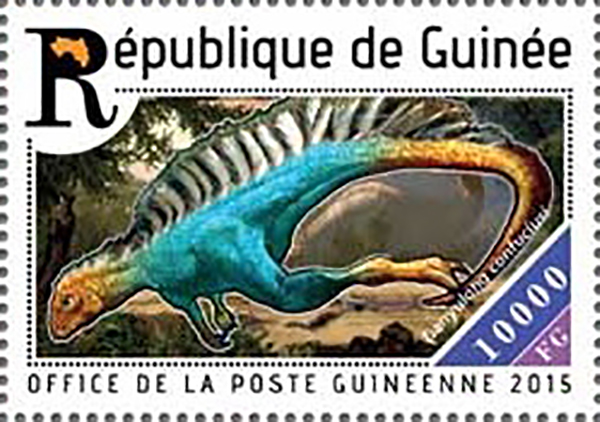Tianyulong confuciusi Zheng, You, Xu, Dong, 2009

(Da: en.wikipedia.org)
Phylum: Chordata Haeckel, 1874
Subphylum: Vertebrata Cuvier, 1812
Classe: Dinosauria Owen, 1841
Ordine: Ornithischia Seeley, 1888
Famiglia: Heterodontosauridae Romer, 1966
Genere: Tianyulong Zheng et al., 2009
Descrizione
L'olotipo è un esemplare subadulto per il quale è stata stimata una lunghezza di circa 70 cm. L'animale è stato classificato tra gli eterodontosauridi. Il ritrovamento ha esteso la distribuzione geografica di questa famiglia all'attuale Asia e ne ha confermato la presenza nel primo Cretaceo. Una caratteristica di questo dinosauro ornistisco è la presenza di lunghi filamenti sul corpo che gli studiosi che lo hanno descritto mettono in relazione con le "protopiume" e piume già osservate su diversi saurischi teropodi (per quanto riguarda gli ornitischi, invece, il solo caso di "qualcosa che si avvicina alle piume" sono le strutture simili a setole trovate in alcuni esemplari del genere Psittacosaurus). Questo può far pensare che strutture come queste fossero presenti già in un antenato comune di saurischi e ornitischi. L'altra ipotesi è che si tratti di strutture simili sviluppatesi però in modo indipendente all'interno dei due gruppi.
Diffusione
Visse nel primo Cretaceo (144-99 milioni di anni fa), i suoi resti sono stati trovati nella parte occidentale della provincia di Liaoning, in Cina e descritti scientificamente nel 2009 da Xiao-Ting Zheng, Hai-Lu You, Xing Xu e Zhi-Ming Dong.
Bibliografia
–Zheng, Xiao-Ting; You, Hai-Lu; Xu, Xing; Dong, Zhi-Ming (19 March 2009). "An Early Cretaceous heterodontosaurid dinosaur with filamentous integumentary structures". Nature. 458 (7236): 333-336.
–Liu Y.-Q. Kuang H.-W., Jiang X.-J., Peng N., Xu H. & Sun H.-Y. (2012). "Timing of the earliest known feathered dinosaurs and transitional pterosaurs older than the Jehol Biota." Palaeogeography, Palaeoclimatology, Palaeoecology (advance online publication).
–Sereno, Paul (2012-03-10). "Taxonomy, morphology, masticatory function and phylogeny of heterodontosaurid dinosaurs". ZooKeys (226): 1-225.
–Richard J. Butler, Jin Liyong, Chen Jun, Pascal Godefroit (2011). "The postcranial osteology and phylogenetic position of the small ornithischian dinosaur Changchunsaurus parvus from the Quantou Formation (Cretaceous: Aptian–Cenomanian) of Jilin Province, north-eastern China". Palaeontology. 54 (3): 667-683.
–Mayr, Gerald; Peters, D. Stephan; Plodowski, Gerhard; Vogel, Olaf (August 2002). "Bristle-like integumentary structures at the tail of the horned dinosaur Psittacosaurus". Naturwissenschaften. 89 (8). Heidelberg: Springer Berlin: 361-365.
–Currie, Philip J.; Pei-ji Chen (2001). "Anatomy of Sinosauropteryx prima from Liaoning, northeastern China" (PDF). Canadian Journal of Earth Sciences. 38 (12). NRC Canada: 1705-1727.
–Xu, Xing; Zheng Xiao-ting; You, Hai-lu (20 January 2009). "A new feather type in a nonavian theropod and the early evolution of feathers". Proceedings of the National Academy of Sciences. 106 (3): 832-4.
–Barrett, Paul M.; Evans, David C.; Campione, Nicolás E. (2015-06-30). "Evolution of dinosaur epidermal structures". Biology Letters. 11 (6): 20150229.
–Greenwold, Matthew J.; Sawyer, Roger H. (June 6, 2013). "Molecular evolution and expression of archosaurian ß-keratins: diversification and expansion of archosaurian ß-keratins and the origin of feather ß-keratins". Journal of Experimental Zoology B. 320 (6): 393-405.

|
Data: 22/06/2015
Emissione: Dinosauri Stato: Guinea |
|---|